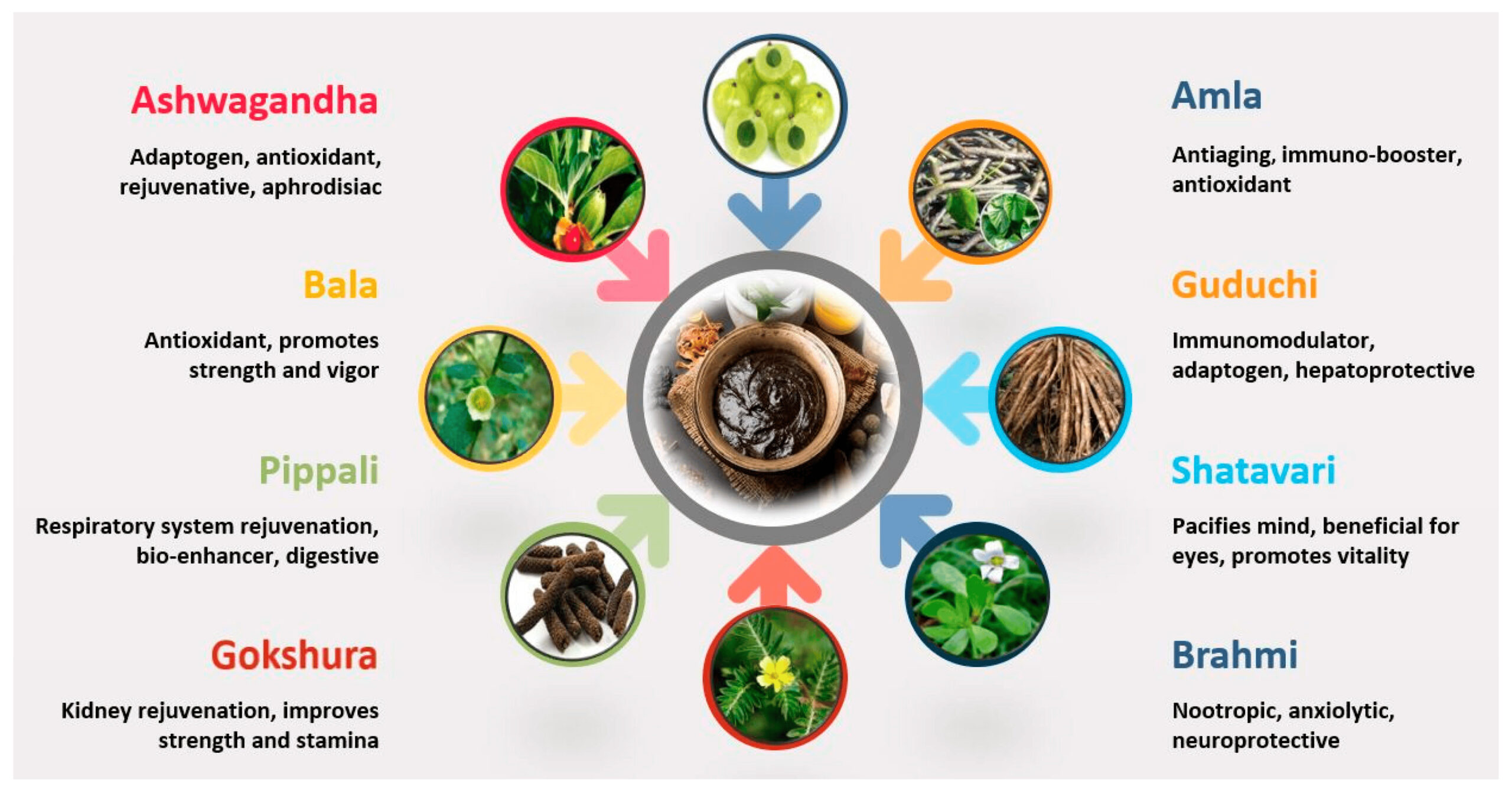Exploring Rasayana (rejuvenation therapy) and its role in promoting longevity and vitality.

Rasayana Chikitsa or Rasayan Therapy, is an Ayurvedic rejuvenation therapy that focuses on strengthening the body and mind. Rasayana therapies are both preventive and curative. Both healthy people and individuals with health issues can take Rasayana Chikitsa, as it helps prevent and cure diseases. It is the therapeutic process of revitalizing and circulating vital fluids for well-being.
Rasayana uses a variety of herbs, therapies, diet, and lifestyle practices to boost the immune system, support good digestion, and reduce stress levels. It aims to delay the aging process and enhance a person’s overall health and vitality.
Rasayana-Chikitsa, a separate speciality branch of Ayurveda is devoted mainly for preservation and promotion of health by revitalizing the metabolism and enhancing immunity. It has therapeutic potential in combating many dreadful diseases of present times like tuberculosis, diabetes, atherosclerosis, dyslipidemia, stroke, Alzheimer’s, cancer etc.
More about Rasayana Therapy:
Rasayana can be broken down into two terms – Rasa and Ayana. According to Ayurveda, RASA refers to the essence of nutrition or the first dhatu, or tissue, formed in a specific order. Ayana refers to the body’s channels, routes, or passages that transport nutrients, food, blood, and other circulatory elements from one cell to another, from one intended tissue to the organ.
Rasayana therapy replenishes the vital fluids of the body; boosts the Ojas (vital force of life) and the immune system, thus keeping away from diseases and prevents against ill effects of advanced age. Rasayana brings about the normalcy of Rasa Dhatu and thereby maintains other dhatus(body tissues) in equilibrium for a longer period. Such a state of improved nutrition prevents ageing which can be understood as Vayasthapana or Jara nashana (geriatric care).
In short, Rasayana Chikitsa is a medicine or treatment procedure that helps the body’s many channels known as Rasaadi Saptha Dhatus (Seven Tissues).
Why is Rasayana needed?

Old cells are replaced by new cells in the growing phase of life. But when the catabolic process dominates over anabolic process, we start growing old. In today’s fast paced world stress is an inescapable part of life due to which this degeneration starts early which can be prevented by Rasayana.
Dietary habits have become faulty and irregular meal times are also hampering metabolism negativity. Moreover, people are becoming addicted to alcohol, smoking and drugs. All these factors are responsible for vitiation of Doshas and Agni, thus causing improper nutrition to the tissues, low immunity, fatigue, debility, inability to adapt to stress and premature aging.
Ideal time to start Rasayan Therapy:
Now the question arises what is the appropriate time of administration of Rasayana? Acharya Shusruta has said “Purvevayasivamadhaye” means the best time for administration of Rasayana is late adult or middle age i.e., 3rd-5th decade of life. During selection of a particular Rasayana various factors like Desha, Kala, Vaya, Prakriti, Dhatu, Agni, Dosha, Dushya & Vayadi (disease) condition should be kept in consideration.
Acharya Sharangdhara has advocated that with every decade of life some important aspect of life is seen to be lost. The selection & administration of Rasayana drugs should be done keeping in mind these losses. Similarly different Rasayana drugs act at different tissue levels hence the affected tissue should also be kept in mind while selecting Rasayana.

Rasayana treatment is more effective when administered following Panchakarma treatment.
Benefits of Rasayana Therapy:
- Long life
- Heightened Memory and Intelligence
- Freedom from Disease
- Excellence of Lustre
- They help to replenish the vital fluids of the body
- Delays aging and promotes longevity
- Maintains proper mental health.
- Quick recovery from diseases.
- It nourishes the blood and other vital tissues of the body.
Rasayana is more than internal treatments. It promotes healthy lifestyle adjustments.
Classification of Rasayana Therapy
Based on the method of administration:
- Indoor admission regimen (kutipraveshika)
- Outdoor regimen (vataatapika)
1. Indoor admission regimen (kutipraveshika): The rasayana therapy is administered in a specially constructed chamber (kuti). The person is isolated in the chamber. Strict regulations in diet, mental and physical activities are prescribed with a suitably controlled atmosphere. The therapy is wholly focused on physical, mental and spiritual upliftment of the person avoiding all external factors that can affect health.
2. Outdoor regimen (vatatapika): In this type, the rasayana therapy is administered in the outdoor regimen. The person is exposed to the external atmosphere (vata) and sunlight (atapa). The person can live everyday social life with rasayana therapy. The restrictions are comparatively less.
Classification based on effect:
- Kamya rasayana: It is aimed to attain desirable specific benefits such as long life, great intelligence, wealth etc.
- Naimittika Rasayana: It is a therapy aimed to treat specific diseases.
- Ajasrikam: This therapy is advised to follow daily, and the person is habituated to the substance.
Classification based on treatment principle:
The disease-specific rasayana, tissue-specific rasayana and organ-specific rasayana are administered to improve health based on underlying disease pathogenesis.
Rasayana dravyas consist of herbs such as Brahmi, amrutha, jatamansi, yashtimadu, shankhapushpi, Manisha, and lorra.
Other types of Rasayana:
- Medhya Rasayana – This group of Rasayana have memory and intellect enhancing properties. They improve the (intellect) Dhi, (retention power) Dhriti and (recalling power) Smriti. Although all the Rasayana drugs are having these properties but special four drugs have been mentioned in improving the higher mental functions. They are Guduchi, Madhuyashti, Mandukparni and Shankhpushpi.
- Aachara Rasayana – Achara-Rasayana is basically the non pharmacological way of acquiring the Rasayana effect with good personal, moral and social behaviour.
In this type of Rasayana, the ways of living, role of Satvika diet, what to do and what to avoid have been described. By following the principles of Achara Rasayana, a person can achieve psychological and social satisfaction which is essential for a healthy living.
Role of Rasayana Therapy:

- Rasayana as anti-oxidants: The effect of rasayana therapy is assessed by its capacity to manage oxidative stress and prevent cellular damage. Rasayan herbs are proven anti-oxidants which help to minimize cellular damage.
- Adaptogenic activitiy: Adaptogenic substances are defined as “substances meant to put the organism into a state of nonspecific heightened resistance in order to resist stresses and adapt to extraordinary challenges”. In Ayurvedic perspectives, the adaptogenic activity can be due to stable (sthira), heavy (guru) and cold (sheeta) potency. These qualities lead to stability, increased endurance and can slow the responses. Kapha dosha possesses all the three qualities, while vata dosha shows the contrary characteristics. Adaptogens can be a drug with pro-kapha and vata stabilizer activity. The substances that have similar properties can be used as rasayana with adaptogenic activities.
- Nutraceutical effect: Rasayana therapy can promote digestion at the microcellular level and promote microcirculation. The rasayana herbs are rich in micronutrients. They provide optimal nutrition to the body tissues (dhatus). They can prevent ageing. Rasayana herbs have shown tissue and disease specific immunomodulatory action and also help to promote or restore functional immunity. It may also help to develop a micro environment in which a cell or tissue can grow smoothly.
- Immuno-modulatory: Rasayana therapy can improve immune response through immunomodulatory activity. Immune stimulants bring about a heightened resistance through the stimulation of non-specific defensive processes, largely independent of antigens. In Ayurveda, immunity is dependent on the status of ojas, kaphadosha and quality of rasa dhatu. Therefore, a rasayana herb that can improve rasa, kapha and ojas can act as an immunomodulator. Phyllanthus emblica (amalaki) and Tinospora cordifolia (guduchi) are proven for their immunomodulatory activity.
- Nootropics (cognition enhancers): The medhya rasayana herbs promoting intellectual and memory functions can act as nootropics. These can improve the higher integrative brain functions, such as memory, learning, understanding, thinking, and concentration capacity. It is assumed that nootropics stimulate existing neural synapses to optimum performance (adaptive capacity). This reduces damaging influences, such as disturbances of the energy and neurotransmitter metabolism or ischemia (protective capacity). The rasayana diet, herbs and regimen that influence intellect (dhi), restraint (dhriti) and memory (smriti) are nootropics. This again indicates the vata-pitta stabilizer and pro-kapha profile of the rasayana.
- Anabolics: These substances activate anabolism. They promote growth by synthesis of nucleic acids and protein metabolism. The rasayna herbs listed in vitalizer (jeevaniya), anti-aging (vayasthapana) category can promote strength (balya), bulk (pushti) and nourishment (brimhana).
In the holistic paradigm of Ayurveda, Rasayana therapy occupies a central position as a cornerstone of preventive healthcare and longevity. By harnessing the healing power of nature and adhering to time-tested principles, Rasayanas offer a holistic approach to wellness that encompasses the physical, mental, and spiritual dimensions of health. Incorporating Rasayana therapy into one’s lifestyle can pave the way for a life of vitality, longevity, and radiant well-being.

Author: Dr. Gayatri Kulkarni – Mulye
MD ( Ayurved)
Special proficiency in Gynecological disorders and Infertility.
Practicing since 12 years at Orthoved hospital, Dombivli,
